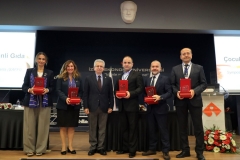
VOCATIONAL SCHOOL OF HEALTH SERVICES
Department of Child Development
CG 206 | Course Introduction and Application Information
| Course Name |
Art and Creativity in Child
|
|
Code
|
Semester
|
Theory
(hour/week) |
Application/Lab
(hour/week) |
Local Credits
|
ECTS
|
|
CG 206
|
Spring
|
1
|
2
|
2
|
3
|
| Prerequisites |
None
|
|||||
| Course Language |
Turkish
|
|||||
| Course Type |
Required
|
|||||
| Course Level |
Short Cycle
|
|||||
| Mode of Delivery | Blended | |||||
| Teaching Methods and Techniques of the Course | Group WorkPerformanceLecture / Presentation | |||||
| Course Coordinator | - | |||||
| Course Lecturer(s) | ||||||
| Assistant(s) | - | |||||
| Course Objectives | This course is designed for students;to gain creative thinking ability by improving their creativity, to communicate with their children and to use them during activities and activities to be done with children, Arts and art development in early childhood is aimed to gain the ability to plan and implement the necessary studies. |
| Learning Outcomes |
The students who succeeded in this course;
|
| Course Description | This course covers the role of the teacher in the development of creativity and creativity in early childhood, art development in early childhood, and the place of artwork in the educational program. |
|
|
Core Courses | |
| Major Area Courses |
X
|
|
| Supportive Courses | ||
| Media and Management Skills Courses | ||
| Transferable Skill Courses |
WEEKLY SUBJECTS AND RELATED PREPARATION STUDIES
| Week | Subjects | Related Preparation |
| 1 | Creativity and Creative Individual Features | Neriman Aral, “Çocuklarda Sanat ve Yaratıcılığın Gelişimi”, Nobel Yayınları, 4-19. Yaratıcılık ve Yaratıcı Bireyin Özellikler PPT Sunumu |
| 2 | Preschool Creativity | Nilgün Cevher Kalburan, “Erken Çocukluk Döneminde Yaratıcılık ve Sanat”, Eğiten Kitap Yayınları, 5-8. Yaratıcılık ve Yaratıcı Bireyin Özellikler PPT Sunumu |
| 3 | The Role of the Educator in the Development of Creativity and Supporting Creativity in Early Childhood | Neriman Aral, “Çocuklarda Sanat ve Yaratıcılığın Gelişimi”, Nobel Yayınları, 118-167. Sanat ve Estetik PPT Sunumu |
| 4 | Mask and Costume Design | Neriman Aral, “Çocuklarda Sanat ve Yaratıcılığın Gelişimi”, Nobel Yayınları, 90-115. Erken Çocukluk Döneminde Sanat PPT Sunumu |
| 5 | Mask and Costume Design | Nilgün Cevher Kalburan, “Erken Çocukluk Döneminde Yaratıcılık ve Sanat”, Eğiten Kitap Yayınları, 5-21, 79-199. Neriman Aral, “Çocuklarda Sanat ve Yaratıcılığın Gelişimi”, Nobel Yayınları, 204-223. Sanat Çalışmalarının Eğitim Programındaki Yeri PPT Sunumu |
| 6 | Midterm Exam | Sanat Çalışmalarının Eğitim Programındaki Yeri PPT Sunumu |
| 7 | Mask and Costume Design | Place of Artworks in Education Program PPT Presentation |
| 8 | Art and Aesthetics | Neriman Aral, “Development of Art and Creativity in Children”, Nobel Publications, 118-167. Art and Aesthetics PPT Presentation |
| 9 | Art in Early Childhood | Place of Artworks in Education Program PPT Presentation |
| 10 | The Place of Art Studies in the Education Program | Place of Artworks in Education Program PPT Presentation |
| 11 | Poetry and Art | Place of Artworks in Education Program PPT Presentation |
| 12 | Museum and Art | Place of Artworks in Education Program PPT Presentation |
| 13 | Puppet Design | Place of Artworks in Education Program PPT Presentation |
| 14 | Puppet Design | Place of Artworks in Education Program PPT Presentation |
| 15 | Evaluation of the term | |
| 16 | Final Exam |
| Course Notes/Textbooks |
2. Nilgün Cevher Kalburan, Erken Çocukluk Döneminde Sanat ve Yaratıcılık, 2011, ISBN: 9786055472511 |
| Suggested Readings/Materials |
|
EVALUATION SYSTEM
| Semester Activities | Number | Weigthing |
| Participation |
1
|
6
|
| Laboratory / Application |
1
|
6
|
| Field Work | ||
| Quizzes / Studio Critiques | ||
| Portfolio | ||
| Homework / Assignments |
1
|
12
|
| Presentation / Jury | ||
| Project |
1
|
16
|
| Seminar / Workshop | ||
| Oral Exams | ||
| Midterm |
1
|
20
|
| Final Exam |
1
|
40
|
| Total |
| Weighting of Semester Activities on the Final Grade |
5
|
60
|
| Weighting of End-of-Semester Activities on the Final Grade |
1
|
40
|
| Total |
ECTS / WORKLOAD TABLE
| Semester Activities | Number | Duration (Hours) | Workload |
|---|---|---|---|
| Theoretical Course Hours (Including exam week: 16 x total hours) |
16
|
1
|
16
|
| Laboratory / Application Hours (Including exam week: '.16.' x total hours) |
16
|
2
|
32
|
| Study Hours Out of Class |
0
|
||
| Field Work |
0
|
||
| Quizzes / Studio Critiques |
0
|
||
| Portfolio |
0
|
||
| Homework / Assignments |
2
|
4
|
8
|
| Presentation / Jury |
0
|
||
| Project |
2
|
8
|
16
|
| Seminar / Workshop |
0
|
||
| Oral Exam |
0
|
||
| Midterms |
1
|
8
|
8
|
| Final Exam |
1
|
10
|
10
|
| Total |
90
|
COURSE LEARNING OUTCOMES AND PROGRAM QUALIFICATIONS RELATIONSHIP
|
#
|
Program Competencies/Outcomes |
* Contribution Level
|
||||
|
1
|
2
|
3
|
4
|
5
|
||
| 1 | To have the required contemporary theoretical and practical knowledge in his/her field |
X | ||||
| 2 | To use the material and technology related to his/her field, and make their maintenance, use the information and communication technologies at basic level |
X | ||||
| 3 | To have the competency to recognize the problems in his/her field, analyze them, develop evidence-based solutions and have the ability to share their suggestions with others |
|||||
| 4 | To be aware of legal responsibilities, conduct basic studies in her/his field independently |
X | ||||
| 5 | To communicate with patients, relatives and colleagues properly, comprehensively, honestly and explicitly, transfer his/her thoughts and knowledge through written and oral communication |
|||||
| 6 | To take responsibility as an active team member during the practices in his/her field |
|||||
| 7 | To commentate and evaluate the scientific information with a critical approach by the help of knowledge gained in his/her field |
|||||
| 8 | To comprehend the importance of lifelong learning, to determine and meet her/his learning needs, to develop herself/himself by monitoring the development in science and technology |
|||||
| 9 | To act by considering the universal ethical values, social and cultural characteristics |
|||||
| 10 | To know the concepts of occupational safety, patient safety, environmental protection and quality, and fulfill the requirements |
|||||
| 11 | To be able to follow information in his field and communicate with colleagues in English at least a level of European Language Portfolio A2 General Level |
|||||
| 12 | To have the skills of improving the development and learning of children with special needs |
X | ||||
| 13 | To plan and carry out activities for development of people under their responsibility |
|||||
*1 Lowest, 2 Low, 3 Average, 4 High, 5 Highest


